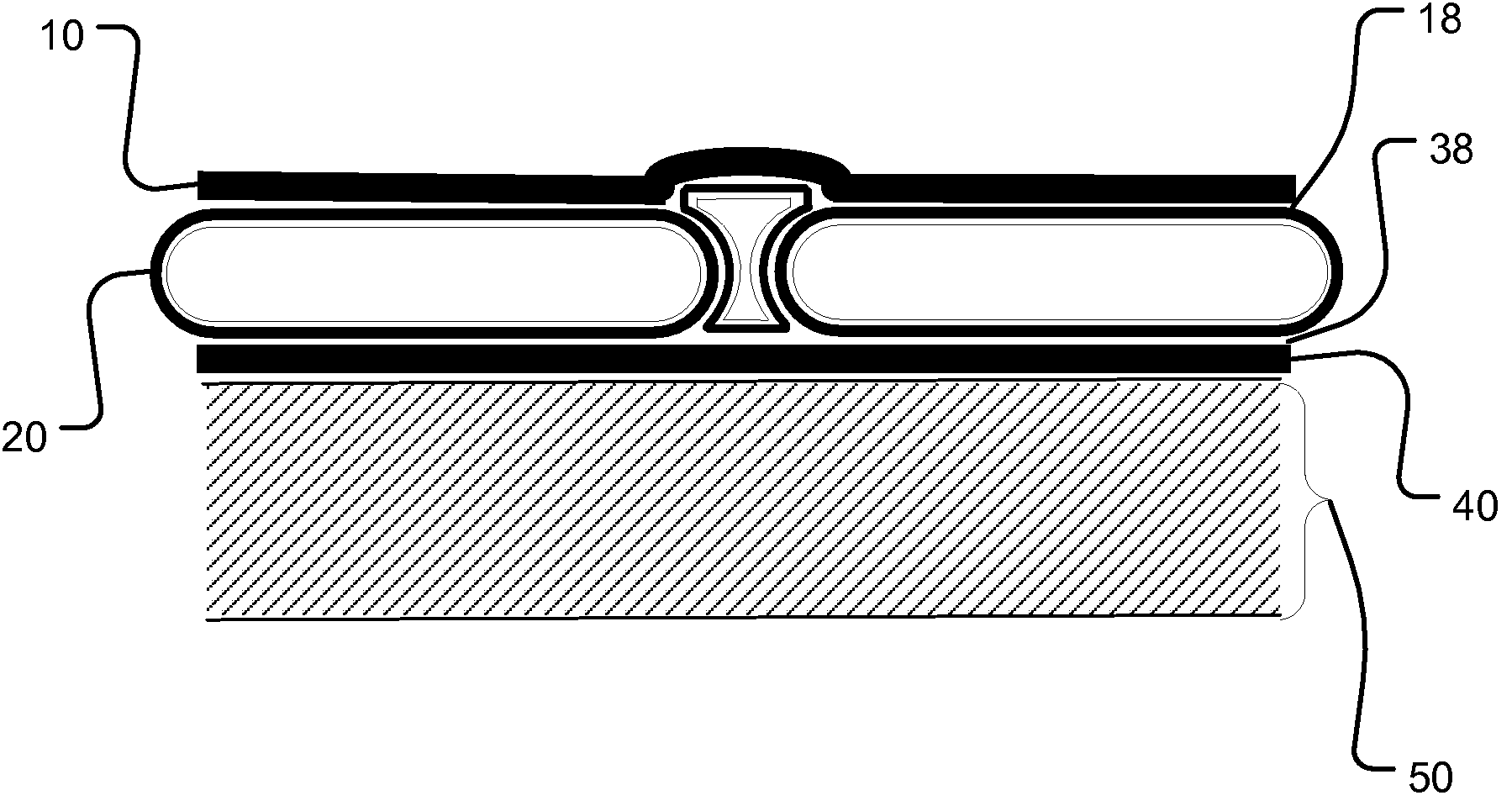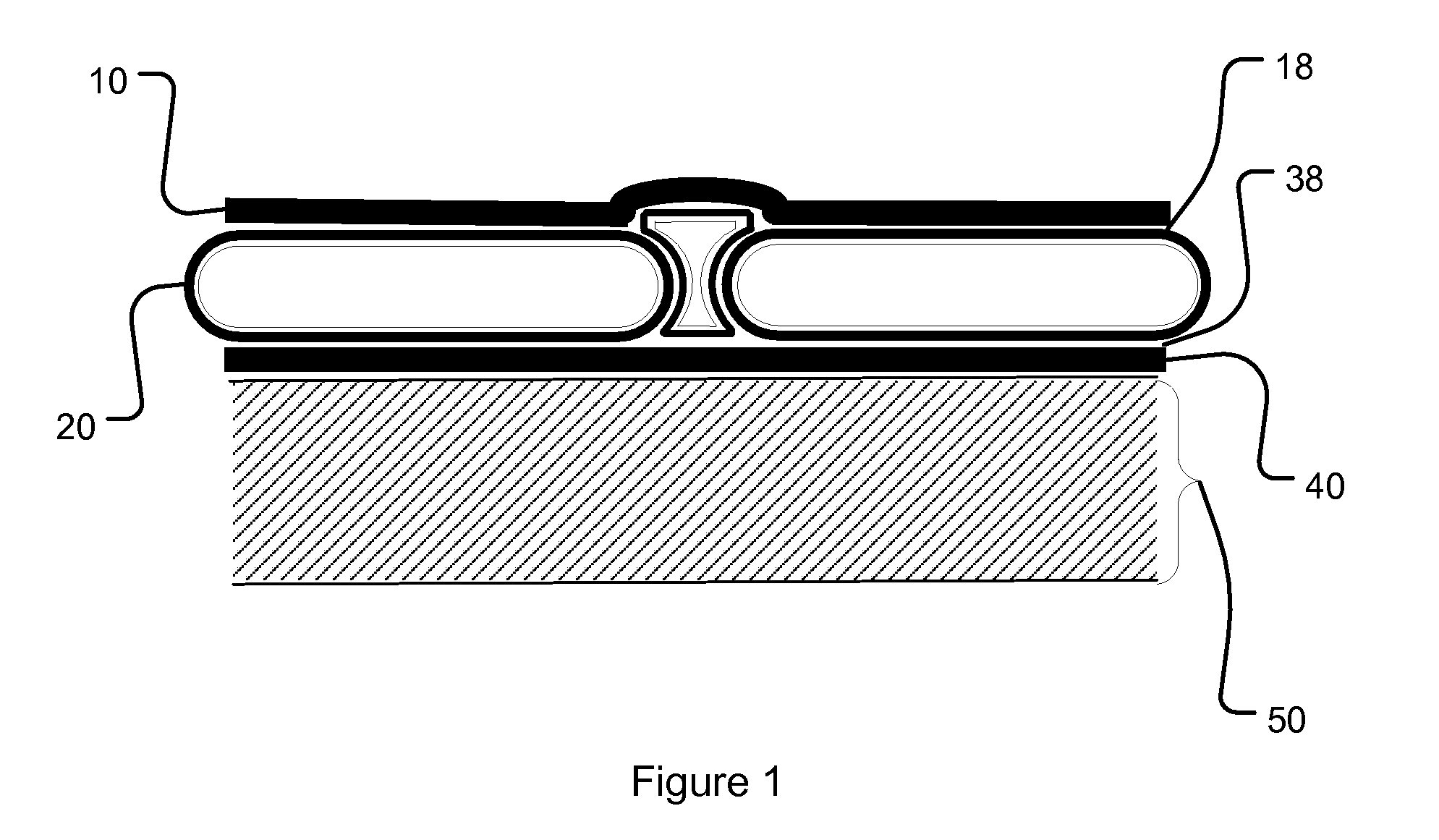Mosaic extremity protection system with transportable solid elements
a technology of solid elements and mosaic extremities, applied in the field of protective systems, can solve the problems of b4c's historically not sintered well, the porosity severely degrades the ballistic properties of ceramic armor, and the cost, density and total system mass of the system, and achieves the effect of efficient capture and dissipation of kinetic energy in a ballistic projectile, adequate range of flexure, and readily available resources
- Summary
- Abstract
- Description
- Claims
- Application Information
AI Technical Summary
Benefits of technology
Problems solved by technology
Method used
Image
Examples
example 1
[0108]B4C ceramic of at least 99.5% density is wrapped with six plies of four-layer Dyneema UDPE tape. The ceramic is 5 mm thick with a 50 mm square format. The edge bars have a full radius undercut to their T profile matching the wrapped thickness and edge profile of the SE. The EB is 8 mm high and has the same wrap as the SE component. The spall cover is two layers of 6 oz / yd2 knit lycra-nylon material bonded to the face of the SE wrap with Loctite 3030 PE grade low temperature adhesive. The flex backer is four plys of 3 oz / yd2 840 Denier / 70 / 2 staple composite fabric bonded with a cement coating of AC grade Neoprene. The underside SE wrap is bonded to the flex backer with the same Loctite adhesive. The fiber pack consists of up to 1.5 lb / ft2 of Dyneema shield material in combination with the composite yarn Twarron woven in the ⅓-⅓-⅓ configuration with UDPE materials on the outer faces.
[0109]This and similar embodiments may have a construction sequence as follows. The solid element...
example 2
[0116]Another example of the invention uses ceramic-fiber solid element SEs that are three sided, 50 mm on a side. The slightly crowned ceramic core has a 6 mm dome height and an actual thickness of 5 mm. The SE / EB joint has a gap / height ratio of less than 25%. The ceramic core is of B4C material, TCE pre-stressed. The edge bars EB have the three facet end cut or face of FIG. 3, a T cross section profile size of 9 mm high and 9 mm wide, and are made of B4C ceramic. The center buttons CB are 20 mm diameter, 11 mm high at the domed top, including a shank that is 10 mm long, and are made of B4C ceramic. The rigid fiber covering wrap on all components consists of PBO 500 denier woven 5-10 ply material and high modulus epoxy B stage materials. The wrap is 1.5 mm thick. The flex backer is of an aramid-elastomeric design using three to twelve layers of 840 d composite yarn fabric. The system mass at this point is about 5 lb / ft2. The fiber pack consists of wovens and / or unidirectional fiber...
example 3
[0117]Another example of the invention uses square ceramic-fiber solid elements (SE), the outer layer or wrap of which is a fiber laminate. The SEs are 75 mm on a side, of 5 mm thickness, after a steel containment layer is brazed to the ceramic core. The SE core material is of B4C material with TCE compression. The SE / EB / SE interfaces have a contact interface or zero gap, at zero degrees of flexure. The edge bars have a slightly domed T cross section profile 8 mm wide×9 mm high and are made of B4C material. The center button is 20 mm diameter and 10 mm high with its domed top, and make of B4C material. The rigid fiber cover wrap is of PBO material, 500 denier woven, five to ten plys, and uses high modulus epoxy B stage materials. The flex backer is of an aramid-elastomer construction, using three to twelve layers of 840 maximum denier composite yarn fabric. The fiber pack is as described in the prior example.
PUM
| Property | Measurement | Unit |
|---|---|---|
| elongation to break | aaaaa | aaaaa |
| elongation | aaaaa | aaaaa |
| velocities | aaaaa | aaaaa |
Abstract
Description
Claims
Application Information
 Login to View More
Login to View More - R&D
- Intellectual Property
- Life Sciences
- Materials
- Tech Scout
- Unparalleled Data Quality
- Higher Quality Content
- 60% Fewer Hallucinations
Browse by: Latest US Patents, China's latest patents, Technical Efficacy Thesaurus, Application Domain, Technology Topic, Popular Technical Reports.
© 2025 PatSnap. All rights reserved.Legal|Privacy policy|Modern Slavery Act Transparency Statement|Sitemap|About US| Contact US: help@patsnap.com



